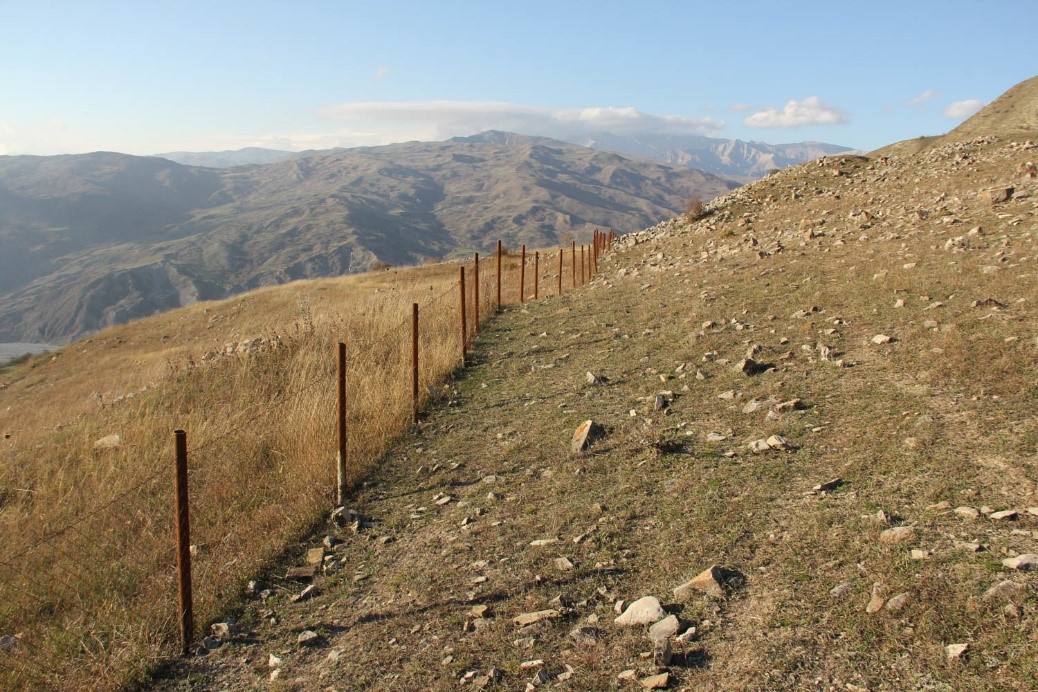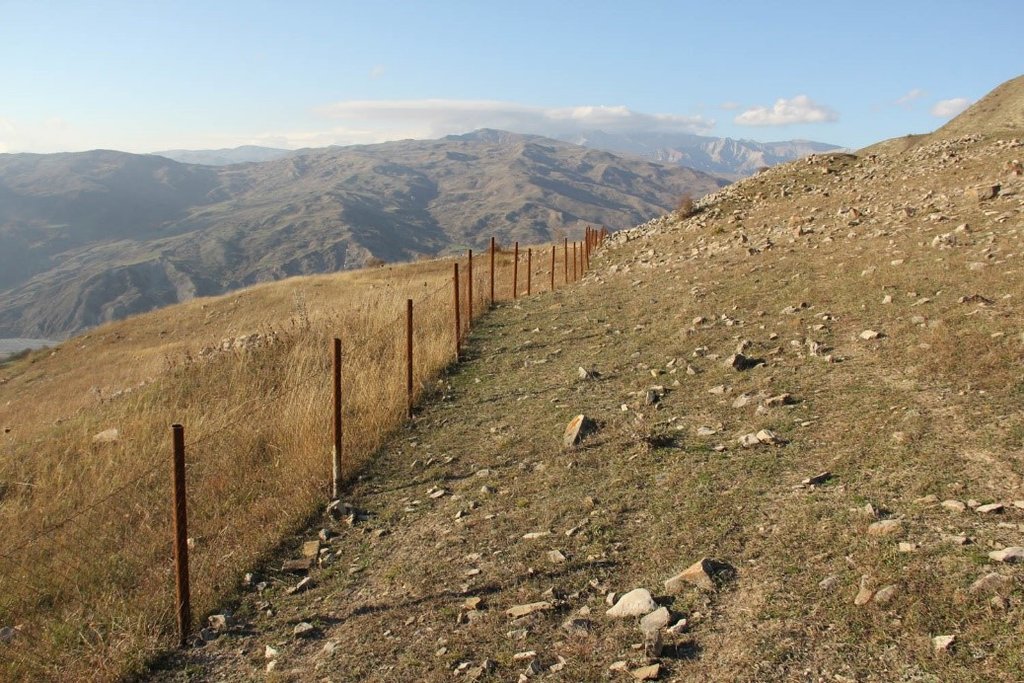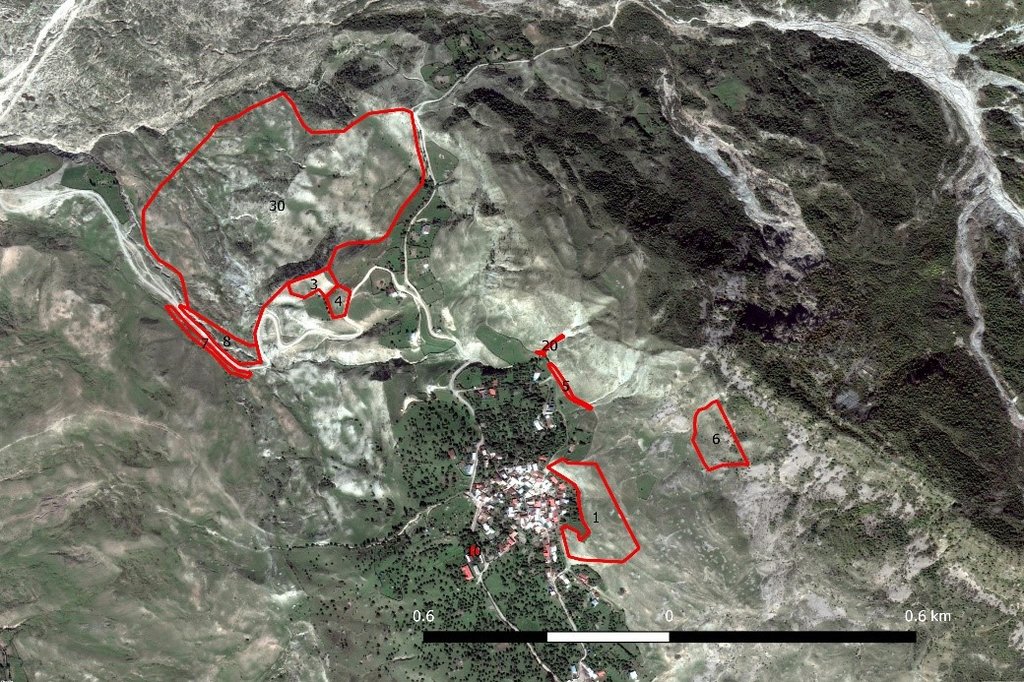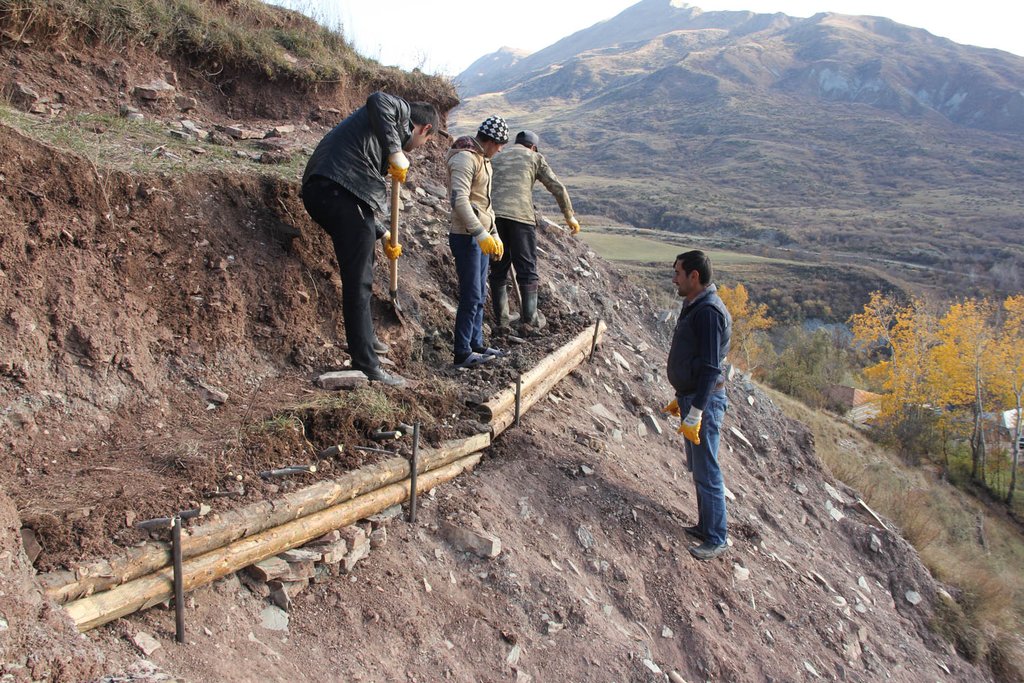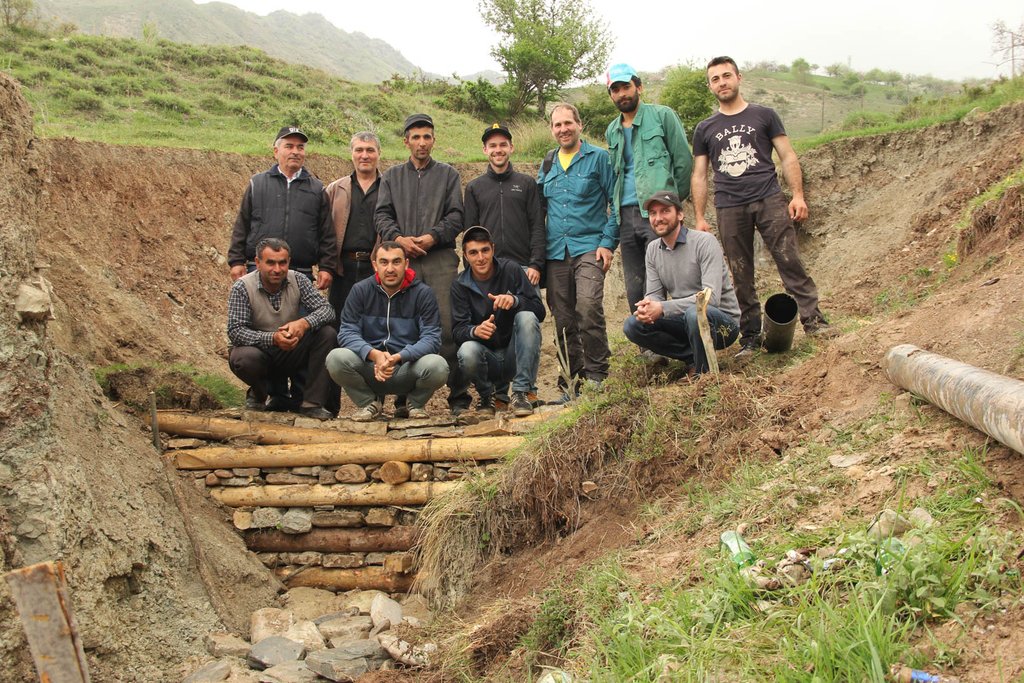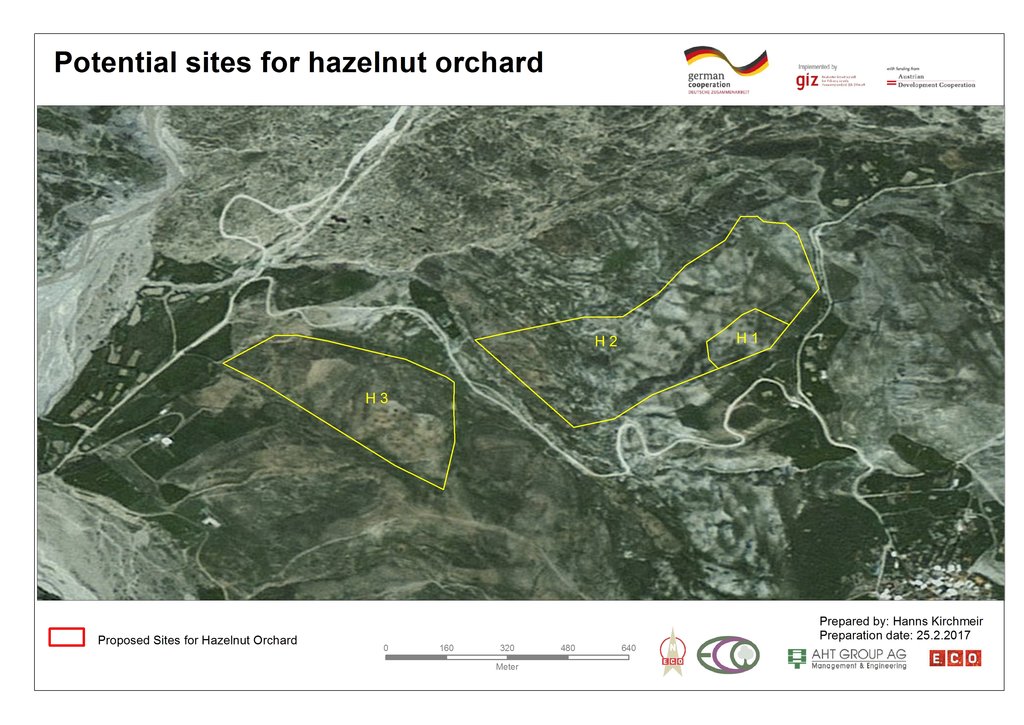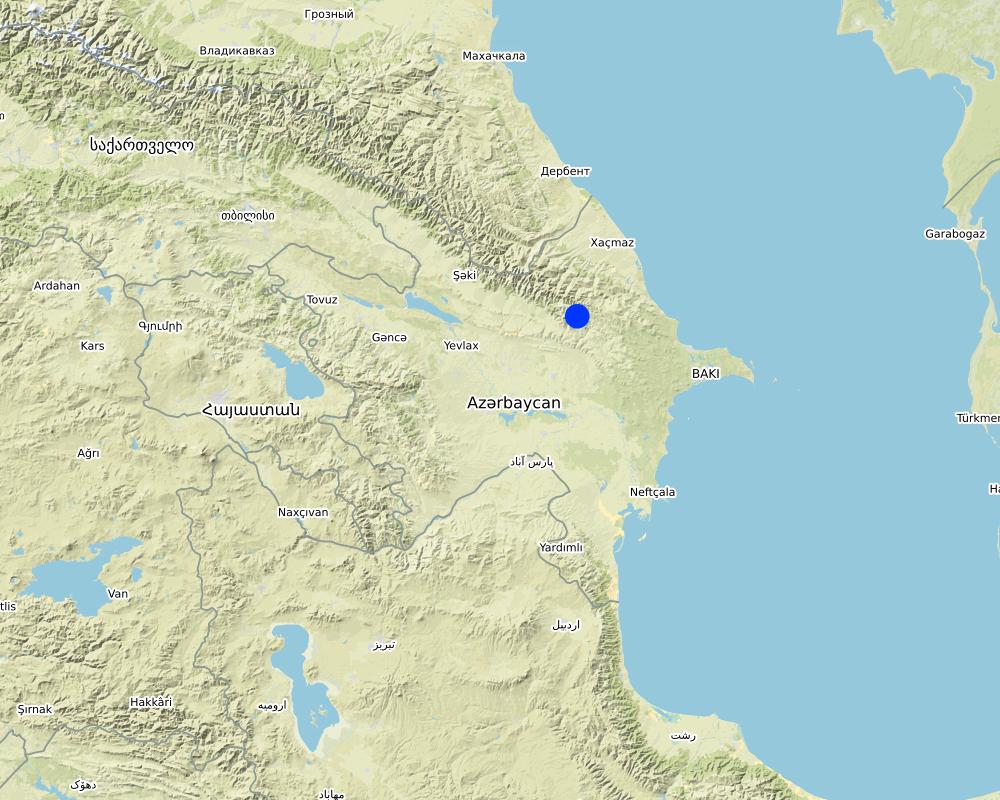Community-based approach in Erosion Control [Azerbaïdjan]
- Création :
- Mise à jour :
- Compilateur : Hanns Kirchmeir
- Rédacteurs : Markus Koeppler, Samir Abbasov
- Examinateur : Rima Mekdaschi Studer
Ismayilly district, Ehen community
approaches_5571 - Azerbaïdjan
Voir les sections
Développer tout Réduire tout1. Informations générales
1.2 Coordonnées des personnes-ressources et des institutions impliquées dans l'évaluation et la documentation de l'Approche
Spécialiste GDT:
Nom du projet qui a facilité la documentation/ l'évaluation de l'Approche (si pertinent)
Integrated Biodiversity Management, South Caucasus (IBiS)Nom du ou des institutions qui ont facilité la documentation/ l'évaluation de l'Approche (si pertinent)
Deutsche Gesellschaft für Internationale Zusammenarbeit (GIZ)1.3 Conditions relatives à l'utilisation par WOCAT des données documentées
Quand les données ont-elles été compilées (sur le terrain)?
31/10/2018
Le compilateur et la(les) personne(s) ressource(s) acceptent les conditions relatives à l'utilisation par WOCAT des données documentées:
Oui
1.4 Références au(x) questionnaire(s) sur les Technologies de GDT
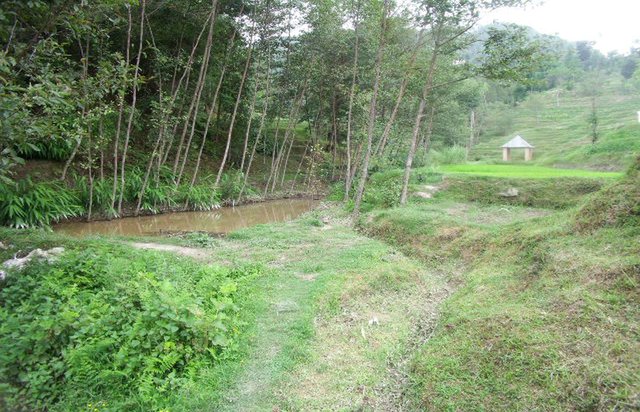
Sustainable land management using controlled gullying [Népal]
An indigenous technology to help control channelled water during the rainy season and conserve it during the dry season
- Compilateur : Shreedip Sigdel
2. Description de l'Approche de GDT
2.1 Courte description de l'Approche
The unsustainable use of pastures and forest areas leads to erosion, degradation, desertification and loss of biodiversity in high mountain areas of the South Caucasus. In the village Ehen in the Ismayilli district in Azerbaijan, a community-based approach for erosion control was developed in a participative way. Together with village stakeholders, different measures were developed to stop erosive processes, flooding and to rehabilitate vegetation cover.
2.2 Description détaillée de l'Approche
Description détaillée de l'Approche:
The Ministry of Ecology and Natural Resources of Azerbaijan togehter witht the Deutsche Gesellschaft fuer Zusammenarbeit (GIZ) selected integrated erosion control as a priority in their cooperation and the district Ismayilli was choosen for the implementation of pilot activities.
The district Ismayilli covers an area of about 2.158 km². Approximately 31% of the territory is covered with forest. Pasture lands on slopes are particularly exposed to vegetation degradation due to overgrazing. The loss of a closed vegetation cover on mountain slopes can lead to severe soil erosion due to surface water runoff. The project team together with the district administration decided to set the focus on the village Ehen near Lahic.
The approach chosen for integrated erosion control in Ehen was a community-based approach. Together with stakeholders, the most severe erosion sites were identified, and a list of priorities was developed. In cooperation with international experts, different technologies and practices were developed to stop erosion processes. Several preconditions for the development of a number of practices were set: The technologies should be cost-effective and affordable for the villagers, and the villagers should be able to use them without the use of external technicians. In order to achieve this, particular emphasis was placed on the application of bio-engineering measures. Measures were applied on degraded pasture lands and erosion gullies in the pilot community at the south slope of the Great Caucasus.
As a first step, the implementation sites were determined through joint field visits by village representatives and experts ('Screening mission'). In the first face the GIZ-team and the SLM-experts have been introduced to the village community. In this phase, the national GIZ project coordinator had the major role to create a basis of respect and trust to enable a positive athomisphere for an open minded discussion. The driving factors of deforestation and overgrazing were discussed in the field, and the potential intervention sites were marked with colour spray and wooden poles in the field. The marking in the field instead of only working with printed maps was very important for the recognition, discussion and acceptance of the sites by all villagers. There was a gap of several weeks between marking and implementation, which provided enough time for internal discussion about the site selection and the adaptation of boundaries.
Nine degraded pastures and forest land sites were selected by the village stakeholders togehter witht the SLM specialists. Four sites are located above the village with the risk of increasing rockfall and flooding by surface water runoff. Five sites are located below the village and were selected to ensure the productivity of the land. For providing tree seedlings, a local tree nursery was established near the school (10th site). One site was selected to combine effects by establishing a hazelnut plantation to stop erosion, increase vegetation cover and provide an income generation opportunity.
Two sites with gully erosion were selected: a site above the village with the risk of flooding into the village and a site below the village along the road with a high risk of road damage if the deepening process continues (detailed instructions on measures can be found at the internet links attached).
Regular meetings took place between the traditional administrative community board, the GIZ-project team and the SLM experts to discuss the implementation process and to evaluate together the results. The availability of local resources was taken into consideration to adapt technologies to fit the local needs. New ideas, localy available materials and technologies have beein integrated into the implementation process by the local stakeholders.
The implementation of the measures was done mainly by the local village people and local experts. The SLM experts provided 'hands-on-training' and all materials that were not available in the village as well external experts were financed by the project.
Another essential aspect is the sustainable use of well-managed meadows by different stakeholders (beekeepers, wild herb collectors, orchard owners and others) in the community. This includes the agreement (rule) of the community to share the protected pastures and to consider the needs of all interest groups. The decission of the profit sharing is taken by the taditional administrative community board. A further factor was the establishment of a tree nursery, which led to an increased motivation to plant additional trees (especially fruit trees) in the community.
2.3 Photos de l'approche
Remarques générales concernant les photos:
The soil condition is very poor regarding humus.
2.4 Vidéos de l'Approche
2.5 Pays/ région/ lieux où l'Approche a été appliquée
Pays:
Azerbaïdjan
Région/ Etat/ Province:
Ehen village
Autres spécifications du lieu :
DIistrict Ismayilli
Commentaires:
The pilot sites belong to Ehen village within the district Ismayilli.
Map
×2.6 Dates de début et de fin de l'Approche
Indiquez l'année de démarrage:
2015
Si l'année précise est inconnue, indiquez approximativement quand l'Approche a démarré:
il y a moins de 10 ans (récemment)
Date (année) de fin de l'Approche (si l'Approche n'est plus appliquée):
2018
Commentaires:
At the 10 locations of the village Ehen the implementation of the approach took place in the years 2016-2018.
2.7 Type d'Approche
- fondé sur un projet/ programme
2.8 Principaux objectifs de l'Approche
Develop erosion control measures that can be implemented by village population without significant investment. The measures are addressed to rehabilitate vegetation on eroded sites and to slow down water speed and erosive energy where gullies already exist. This should help protect roads and other infrastructure as well as stop soil loss and increase overall productivity.
2.9 Conditions favorisant ou entravant la mise en œuvre de la(des) Technologie(s) appliquée(s) sous l'Approche
normes et valeurs sociales/ culturelles/ religieuses
- favorise
Local population tend to save resources such as forest and pasture surrounding their village. Residents, especially women collect wild plants to use in daily life. Furthermore, selling collected wild plants in the market, residents earn income.
disponibilité/ accès aux ressources et services financiers
- favorise
Most of the activities (fencing, willow fascines, pilewalls, gabion or wooden check dams) only need small-scale financial investments. Only the drip irrigation system for the hazelnut orchard needed significant external investment, and the return of the investment cannot be expected before 10 years. Such an investment would have been impossible for the village community without external support.
cadre institutionnel
- favorise
The Community Management Group was established at the early stage of the project.
collaboration/ coordination des acteurs
- favorise
Pilot activities are implemented in cooperation with local decision makers and communities. The active involvement of the village people in the implementation works was a hands-on training.
cadre juridique (régime foncier, droits d'utilisation des terres et de l'eau)
- entrave
The forest’s legal protection does not allow timber or poles to be taken from the forest for the construction of pile walls or wooden check dams. The poles had to be imported and transferred to the village. A balanced sustainable forest management would enable village people to make use of the local timber and would encourage people to establish forest areas.
cadre politique
- favorise
The Azerbaijan policy to establish more than 2000ha of hazelnut orchard in the district of Ismayilli supports the decision to establish hazelnut orchards on eroded sites as a control measure.
gouvernance foncière (prise de décisions, mise en œuvre et application des décisions)
- favorise
Pilot sites are located in municipality land. Community members and local authority decided the border of pilot sites.
connaissances sur la GDT, accès aux supports techniques
- favorise
Residents have some initial knowledge of sustainable land management. Implementing pilot activities their information is developed.
marchés (pour acheter les intrants, vendre les produits) et prix
- favorise
Collected wild plants are sold in the market located next to Ehen village.
charge de travail, disponibilité de la main-d'œuvre
- favorise
The manpower is available in the village
3. Participation et rôles des parties prenantes impliquées dans l'Approche
3.1 Parties prenantes impliquées dans l'Approche et rôles
- exploitants locaux des terres / communautés locales
Livestock farmers, shepherds, smallholder farms and women that were loosely organised.
Selection of sites for intervention, providing labour during implementation of measure, local hay residuals provided by farmers for testing the measure, maintenance of drip irrigation and electric fence of the hazelnut orchards.
- Spécialistes de la GDT/ conseillers agricoles
International and national specialists have been integrated.
The SLM specialist elaborated in close cooperation with the local stakeholders the implementation concept.
- chercheurs
Researcher from the Agrarian University in Ganja.
- gouvernement local
Ministry of Ecology and Natural Resources, Ismayilli District Administration
Numerous pilot activities (test and demonstrate the most appropriate actions and raise awareness of the community on the long-term socio- economic and environmental benefits of the pilot actions) have been implemented In cooperation with local government in Ehen municipality.
3.2 Participation des exploitants locaux des terres/ communautés locales aux différentes phases de l'Approche
| Participation des exploitants locaux des terres/ communautés locales | Spécifiez qui était impliqué et décrivez les activités | |
|---|---|---|
| initiation/ motivation | aucun | The selection of Ismayilli district was done at Ministry level. The selection of the villages was done with district administration and experts assessment of erosion problems. |
| planification | interactive | The site selection was done with local village stakeholders. The technical planning was done by external experts. Four additional municipalities were assessed for hazelnut plantations where local land users provided data. |
| mise en œuvre | interactive | Local stakeholders trained on bioengineering measures. The following measures were applied during hands-on training: 1. Wooden check-dam. 2. Gabion check-dam. 3. Willow-fascines. 4. Electric-Fencing. 5.Pile walls. 6.Drip irrigation system. |
| suivi/ évaluation | interactive | An external monitoring team (project team) did the monitoring in a participative way. The observations and monitoring results were discussed with the village stakeholders. |
3.3 Diagramme/ organigramme (si disponible)
Description:
This flow chart gives an overview on the different roles of project participants (Ministry and GIZ, the national experts and SLM specialists as well as the local stakeholders) and the actions implementented by them jointly or seperately.
3.4 Prises de décision pour la sélection de la Technologie/ des Technologies
Indiquez qui a décidé de la sélection de la Technologie/ des Technologies à mettre en œuvre:
- principalement les spécialistes de la GDT, après consultation des exploitants des terres
Expliquez:
The integrated erosion control measures were developed by SLM specialists, while site selection and prioritization were done in conjunction with village community representatives.
Spécifiez sur quelle base ont été prises les décisions:
- les résultats de recherches?
- expériences et opinions personnelles (non documentées)
4. Soutien technique, renforcement des capacités et gestion des connaissances
4.1 Renforcement des capacités/ formation
Une formation a-t-elle été dispensée aux exploitants des terres/ autres parties prenantes?
Oui
Spécifiez qui a été formé:
- exploitants des terres
- personnels/ conseillers de terrain
Si pertinent, spécifiez le genre, l'âge, le statut, l'ethnie, etc.
Only men have been involved in the training of the application of the erosion control measures.
Formats de la formation:
- sur le tas
- zones de démonstration
Thèmes abordés:
Construction of willow fascines, pill walls, wooden check dams, gabion check dams, tree planting, fence construction (electric fence, mesh wire fence), construction and maintenance of drip irrigation system.
Commentaires:
In addition to the on-the-job training, an Austrian study tour was provided for Georgian participants. The focus of the joint study tour was to enable a direct experience of current practices in the Alps giving the participants an impression how the issue of land management and erosion control is handled in mountainous areas of Austria.
4.2 Service de conseils
Les exploitants des terres ont-ils accès à un service de conseils?
Oui
Spécifiez si le service de conseils est fourni:
- dans les champs des exploitants?
Décrivez/ commentez:
The field trip provided advice and training on afforestation and tree species selection.
4.3 Renforcement des institutions (développement organisationnel)
Des institutions ont elles été mises en place ou renforcées par le biais de l'Approche?
- oui, modérément
Spécifiez à quel(s) niveau(x), ces institutions ont été renforcées ou mises en place:
- local
- régional
- national
Décrivez l'institution, ses rôles et responsabilités, ses membres, etc.
The implementation capacity of line ministries, their subordinate bodies and of training institutions regarding the management of biodiversity and ecosystem services is improved. The regional exchange on sustainable management of biodiversity and ecosystem services is improved.
Précisez le type de soutien:
- renforcement des capacités/ formation
Donnez plus de détails:
Capacities in project planning, implementation and monitoring have been developed. Awareness raising on erosion-caused land degradation and effective, cost-efficient erosion control measures have been applied.
4.4 Suivi et évaluation
Le suivi et l'évaluation font ils partie de l'Approche? :
Oui
Commentaires:
In 2018, monitoring was carried out on the implemented measures in order to assess if additional interventions would be required or if measures had been damaged. Permanent monitoring plots have been established to assess the rehabilitation of vegetation.
Si oui, ce document est-il destiné à être utilisé pour le suivi et l'évaluation?
Oui
Commentaires:
Monitoring reports have been provided by field experts (Azeri) and international experts (English) and are available from GIZ IBiS office.
4.5 Recherche
La recherche a-t-elle fait partie intégrante de l’Approche?
Non
5. Financement et soutien matériel externe
5.1 Budget annuel de la composante GDT de l'Approche
Indiquez le budget annuel de la composante GDT de l'Approche en $ US:
100,00
Si le budget annuel précis n'est pas connu, indiquez une fourchette:
- 10 000-100 000
Commentez (par ex. principales sources de financement/ principaux bailleurs de fonds):
In the framework of the GIZ-program “Integrated Biodiversity Management, South Caucasus” (2015-2019), implemented on behalf of the German Federal Ministry of Economic Cooperation and Development (BMZ).
the amount covers: fencing, electric fensing, hay, pile walls, afforestation, wooden check dams, gabion check dams, other materials and labour on the sites of Ehen.
5.2 Soutiens financiers/ matériels fournis aux exploitants des terres
Les exploitants des terres ont-ils reçu un soutien financier/ matériel pour la mise en œuvre de la Technologie/ des Technologies?
Oui
Si oui, spécifiez le(s) type(s) de soutien, les conditions et les fournisseurs:
Land users were provided materials for erosion control measures and tree nursery. The timber for the pile walls, the mesh wire fence and the electric fencing material as well as well as tanks for rain water collection (for the tree nursery) and irrigation equipment was provided. The local stakeholders provided man power for the mainance of fences and irrigation system and maintaining the tree nursery for free. Workpower for setting up infrastructures like gabions or chech damms was paid.
5.3 Subventions pour des intrants spécifiques (incluant la main d'œuvre)
- main d'œuvre
| Dans quelle mesure | Spécifiez les subventions |
|---|---|
| entièrement financé | Only the construction of technical infrastructure (fence, check dams, irrigation system was paid. Maintenance work was not paid. |
- intrants agricoles
| Spécifiez les intrants subventionnés | Dans quelle mesure | Spécifiez les subventions |
|---|---|---|
| tree nursery | entièrement financé | Equipment (fence, water tanks, irrigation system, tools) have been financed. Seeds have been provided by locals. |
- matériaux de construction
| Spécifiez les intrants subventionnés | Dans quelle mesure | Spécifiez les subventions |
|---|---|---|
| bois | en partie financé | Timber for pile walls was bought and provided, branches for willow fence and fascines was contributed by locals. |
Si la main d'œuvre fournie par les exploitants des terres était un intrant substantiel, elle était:
- récompensée avec un autre soutien matériel
Commentaires:
Fruit trees and walnut trees have been contributed by the project for the afforestation on site 1 near the village.
5.4 Crédits
Des crédits ont-ils été alloués à travers l'Approche pour les activités de GDT?
Non
5.5 Autres incitations ou instruments
D'autres incitations ou instruments ont-ils été utilisés pour promouvoir la mise en œuvre des Technologies de GDT?
Oui
Si oui, spécifiez:
For the implementation of the pilot measures in Ehen, material and payment for labour was provided. There have been some follow up activities in neighboring villages where only the material was provided, as the work was done voluntarily.
6. Analyses d'impact et conclusions
6.1 Impacts de l'Approche
Est-ce que l'Approche a autonomisé les exploitants locaux des terres, amélioré la participation des parties prenantes?
- Non
- Oui, un peu
- Oui, modérément
- Oui, beaucoup
The application of easy-to-use measures for erosion control enabled local land users to arrange land management and erosion control measures by themselves without relying on significant external support. The pilot actions in the village Ehen are used as a showcase for the neighbouring villages.
Est-ce que l'Approche a aidé les exploitants des terres à mettre en œuvre et entretenir les Technologies de GDT?
- Non
- Oui, un peu
- Oui, modérément
- Oui, beaucoup
As a result of the on-the-job training, most of the activities (fencing, pile walls, hay mulch application, wooden and gabion check dams) can now be implemented by the local village stakeholders without external support.
Est-ce que l'Approche a mobilisé/ amélioré l'accès aux ressources financières pour la mise en œuvre de la GDT?
- Non
- Oui, un peu
- Oui, modérément
- Oui, beaucoup
International funds were accessible for the village community and other international donors funded measures in the same village.
Est-ce que l'Approche a amélioré les connaissances et les capacités des exploitants des terres pour mettre en œuvre la GDT?
- Non
- Oui, un peu
- Oui, modérément
- Oui, beaucoup
The involvement of local stakeholders in all stages of planning, site selection and implementation improved capacity and knowledge. It was very important that the work was done mainly by local village people and not by external companies.
Est-ce que l'Approche a amélioré les connaissances et les capacités des autres parties prenantes?
- Non
- Oui, un peu
- Oui, modérément
- Oui, beaucoup
University experts and district-level technicians participated in the planning and implementation. They can act as knowledge hubs.
Est-ce que l'Approche a atténué les conflits?
- Non
- Oui, un peu
- Oui, modérément
- Oui, beaucoup
Est-ce que l'Approche a conduit à améliorer la sécurité alimentaire et/ou la nutrition?
- Non
- Oui, un peu
- Oui, modérément
- Oui, beaucoup
Est-ce que l'Approche a amélioré l'accès aux marchés?
- Non
- Oui, un peu
- Oui, modérément
- Oui, beaucoup
Est-ce que l'Approche a conduit à des emplois, des opportunités de revenus?
- Non
- Oui, un peu
- Oui, modérément
- Oui, beaucoup
Villagers have reported that the improved vegetation in the fenced areas led to significantly higher honey harvest and herb collection for marketing on the bazaar of Lahic village.
Protection from national hazards:
- Non
- Oui, un peu
- Oui, modérément
- Oui, beaucoup
All gabions at the sites in Ehen are functioning well and show the impact of the gully deepening and the wash out at the lower (downhill) end of the gabion. Reduced water speed and the stabilised river bed helped to save the road.
Economic impact and improvement of livelihoods via ECM (Erosion control measures):
- Non
- Oui, un peu
- Oui, modérément
- Oui, beaucoup
In the pilot sites, main economic activities are haymaking, the collection of wild plants, beekeeping and harvesting of nuts (hazelnuts and walnuts). Since there is no more overgrazing in the pilot areas, the plant’s biodiversity is expected to continue increasing, so the bees tend to pollinate more often in these areas. Conducted analyses during the project show that local population would benefit from 97.770 AZN per hectare (97.770 AZN = 57.334,7 USD (as per 01.10.2018)) in the period of 15 years because of the net income coming from beekeeping, haymaking, the collection of wild plants and harvesting of hazelnuts.
Sustainable Land Use:
- Non
- Oui, un peu
- Oui, modérément
- Oui, beaucoup
The approach helps to mitigate land degradation by surface erosion. Hay making, forestry and hazelnut production have been supported as alternative land use on the rehabilitated land. Up until now, only pilot measures have been implemented on limited areas of the village area.
6.2 Principale motivation des exploitants des terres pour mettre en œuvre la GDT
- augmenter la production
Improved vegetation, soil fertility and productivity of the land.
- augmenter la rentabilité/ bénéfice, rapport coûts-bénéfices
The planting of hazelnut trees addressed reduction of erosion and as a second priority the production of hazelnuts for economic purposes.
- réduire la dégradation des terres
Pasture lands on slopes which were exposed to the degradation of vegetation caused by overgrazing. Now grazing is blocked by fencing, and the land use was changed to either hay production, forest or hazelnut production.
- réduire les risques de catastrophe
Gully erosion parallel to the road and further erosion of the gully’s left side which led to destruction of the road. The villagers are reporting that no rock falls and flooding were observed in the years 2017 and 2018 after the application of measures on site 1 above the village.
- conscience environnementale
- améliorer les connaissances et compétences en GDT
6.3 Durabilité des activités de l'Approche
Les exploitants des terres peuvent-ils poursuivre ce qui a été mis en œuvre par le biais de l'Approche (sans soutien extérieur)?
- oui
Si oui, décrivez de quelle manière:
Local stakeholders trained on building and applying measures. The measures (fencing, pile walls, wooden and gabion check dams) are low-cost and can easily be replicated by village stakeholders. Only the drip irrigation system and electric fencing for the hazelnut orchard needs high investment and might not be up-scaled without external support.
6.4 Points forts/ avantages de l'Approche
| Points forts/ avantages/ possibilités du point de vue de l'exploitant des terres |
|---|
| The integration of local stakeholders in the selection of measures and sites helped to address the most 'urgent' problems from the villagers view. |
| It was important to have visual results from the work in a short time. Especially the reduction of flooding was a very positive result as well as the increased number of flowering plants which led to an increase of honey and tea production, which created additional income. Some of the trained techniques have been already transferred by villagers to neighbouring communities. |
|
Most of the beneficiaries see the hazelnut plantation area as a potential source of income in the future and at the same time as a useful measurement for rehabilitation of the biodiversity and measure against erosion. Land users see the implementation of the measures on the site as contribution to the future tourism perspective of the village. |
| The pilot measure is cost-efficient and affordable for local people. It has a positive ratio of cost/benefit. |
| Points forts/ avantages/ possibilités du point de vue du compilateur ou d'une autre personne ressource clé |
|---|
| Measures are easily implemented and materials (mesh wire, willows, seedlings) are available locally. |
| The measures are showing significant impacts in a short time. The rehabilitation of vegetation and the gathering of sediments halting gully deepening is already visible in the first year after implementation. |
| As there is still enough pasture land available and the areas of intervention have been implemented on degraded land, there was no major conflict with shepherds and farmers. |
6.5 Faiblesses/ inconvénients de l'Approche et moyens de les surmonter
| Faiblesses/ inconvénients/ risques du point de vue de l’exploitant des terres | Comment peuvent-ils être surmontés? |
|---|---|
| Low capacity of the municipality was limiting to the management of the drip irrigation and the electric fence. | Handing over the hazelnut orchard to a private cooperative could increase ownership and personal involvement of local stakeholders in orchard maintenance. A long-term business plan and financing model needs to be developed if the approach is to be up-scaled. |
|
Current electric fence of hazelnut plantation is not efficient in protecting area from free roaming animals. It also reflects on the inefficiency of the overseer`s working time, as he spends entire working hours on the controlling the fence which reduces his time on spending on the additional activities like controlling plant growth and irrigation system. |
Changing electrical fence to the ordinary mesh fence or wire fence. |
| Faiblesses/ inconvénients/ risques du point de vue du compilateur ou d'une autre personne ressource clé | Comment peuvent-ils être surmontés? |
|---|---|
| Because of a general ban on forest management, the timber used for pile walls and wooden check dams cannot be extracted from the local forest. | Timber and logs have to be bought from foreign markets. An adaptation of laws on the legal extraction of local timber for certain purpose would be helpful. |
| Hazel needs more than 750 mm annual precipitation. Humidity above 60% in June and July is beneficial. A strong wind is a danger for young trees. Ehen has 500-700m precipitation and significant summer drought. | A drip irrigation system was applied to overcome summer drought in the first couple of years until seedlings have established a sufficient root system to access water from deeper soil layers. |
| The electric fencing and the drip irrigation for the hazelnut plantation and fruit tree plantations above the village need expensive investment and specific skills for mounting and maintenance. | Project investment was used for pilot measures as a demonstration site. The hazelnut orchard can show a positive return on investment within 10-15 years if managed well. |
7. Références et liens
7.1 Méthodes/ sources d'information
- visites de terrain, enquêtes sur le terrain
Five field visits by international experts. Frequent field visits by national field expert provided by GIZ.
- interviews/entretiens avec les exploitants des terres
Intensive meetings and discussions on the current land use and opportunities of alternative land use forms have been applied.
- compilation à partir de rapports et d'autres documents existants
Six mission reports are available. Results have been compiled in a handbook on integrated erosion control and information leaflets ("BioTopics").
7.2 Références des publications disponibles
Titre, auteur, année, ISBN:
Planning meetings, site visit and stakeholder meeting, Hanns Kirchmeir, Azerbaijan 2017.
Disponible à partir d'où? Coût?
Report based on field vists
Titre, auteur, année, ISBN:
Hazelnut plantations on eroded sites in Ismayilli, Hanns Kirchmeir, 2017
Disponible à partir d'où? Coût?
Concept based on surveys and field visits
7.3 Liens vers les informations pertinentes disponibles en ligne
Titre/ description:
Synthesis Report on Erosion control measures 2014-2017
URL:
https://biodivers-southcaucasus.org/uploads/files/5b8655b3db452.pdf
Titre/ description:
Handbook on Integrated Erosion Control
URL:
http://116.203.245.69/uploads/files/IEC%20Handbook_EN.pdf
Liens et modules
Développer tout Réduire toutLiens

Sustainable land management using controlled gullying [Népal]
An indigenous technology to help control channelled water during the rainy season and conserve it during the dry season
- Compilateur : Shreedip Sigdel
Modules
Aucun module trouvé


